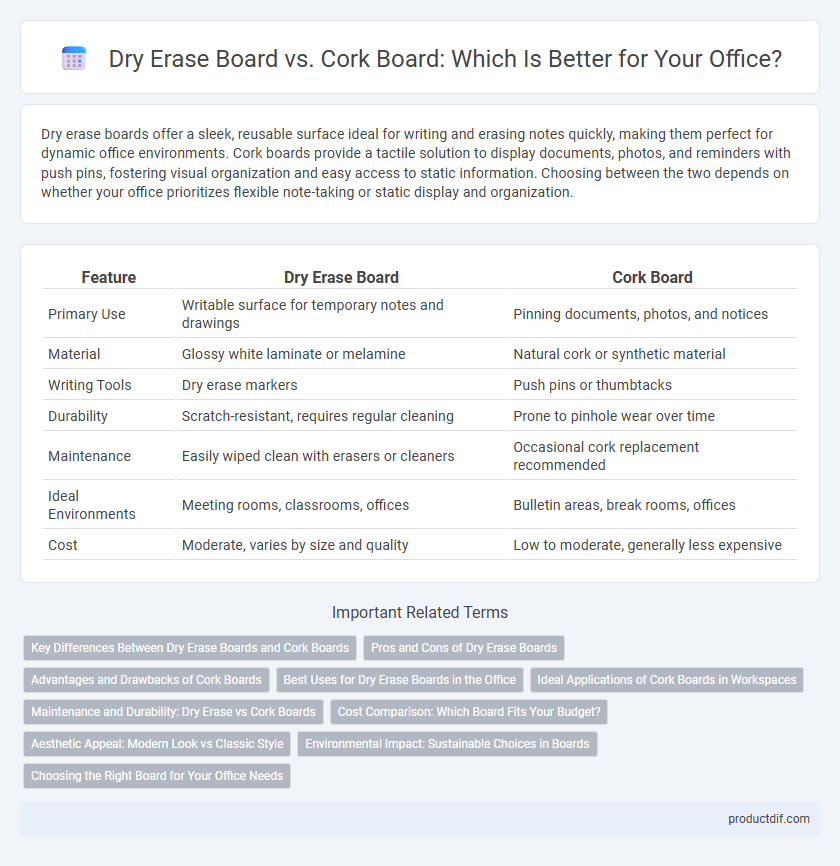Dry erase boards offer a sleek, reusable surface ideal for writing and erasing notes quickly, making them perfect for dynamic office environments. Cork boards provide a tactile solution to display documents, photos, and reminders with push pins, fostering visual organization and easy access to static information. Choosing between the two depends on whether your office prioritizes flexible note-taking or static display and organization.
Table of Comparison
| Feature | Dry Erase Board | Cork Board |
|---|---|---|
| Primary Use | Writable surface for temporary notes and drawings | Pinning documents, photos, and notices |
| Material | Glossy white laminate or melamine | Natural cork or synthetic material |
| Writing Tools | Dry erase markers | Push pins or thumbtacks |
| Durability | Scratch-resistant, requires regular cleaning | Prone to pinhole wear over time |
| Maintenance | Easily wiped clean with erasers or cleaners | Occasional cork replacement recommended |
| Ideal Environments | Meeting rooms, classrooms, offices | Bulletin areas, break rooms, offices |
| Cost | Moderate, varies by size and quality | Low to moderate, generally less expensive |
Key Differences Between Dry Erase Boards and Cork Boards
Dry erase boards utilize a glossy surface for easy writing and erasing with dry markers, ideal for dynamic presentations and quick notes, whereas cork boards feature a natural, pin-friendly texture designed for posting physical documents and reminders. Dry erase boards support reusable, visible content changes without damaging the surface, while cork boards allow tactile interaction by pinning paper or fabric items without writing tools. The choice between dry erase and cork boards depends on the need for temporary, easily editable information versus long-term, tangible display options in office environments.
Pros and Cons of Dry Erase Boards
Dry erase boards offer a smooth, easy-to-clean surface ideal for dynamic presentations and quick note-taking, making them highly reusable and eco-friendly compared to cork boards. They support vibrant, erasable markers that enhance visibility and allow for rapid content updates, yet can suffer from ghosting or staining if not properly maintained. While dry erase boards lack the tactile ability to pin physical documents like cork boards, their versatility and low maintenance make them a preferred choice in modern office environments.
Advantages and Drawbacks of Cork Boards
Cork boards offer excellent versatility for pinning notes, photos, and reminders, making them ideal for visual organization and quick updates in office environments. Their natural cork material is durable, self-healing after pin removal, and eco-friendly, but they can wear out over time with heavy use and may crumble or lose pin-holding strength. Compared to dry erase boards, cork boards lack the ability to easily write and erase text, limiting their use for dynamic, writable content.
Best Uses for Dry Erase Boards in the Office
Dry erase boards excel in office environments for brainstorming sessions, project planning, and quick note-taking, allowing teams to collaborate dynamically and update information in real time. Their smooth, reusable surface supports frequent changes without waste, making them ideal for daily task management and presentations. Unlike cork boards, dry erase boards offer a clean and flexible space that enhances visual communication and team interaction.
Ideal Applications of Cork Boards in Workspaces
Cork boards in workspaces are ideal for pinning important documents, memos, and reminders, providing a tactile and visual organization method that enhances team communication. They support dynamic content display, such as calendars, notes, and project timelines, making them essential for collaborative environments. Cork boards also promote quick accessibility and easy updates without the need for digital devices, fostering a productive and interactive office setting.
Maintenance and Durability: Dry Erase vs Cork Boards
Dry erase boards require regular cleaning with appropriate cleaners to prevent ghosting and maintain surface quality, while cork boards need minimal upkeep aside from occasional dusting and pin removal. Dry erase surfaces are generally more durable against scratches and stains, but may wear out or become less effective over time with heavy use. Cork boards maintain structural integrity longer in moderate to low traffic environments but can degrade or crumble with excessive pin insertion and removal.
Cost Comparison: Which Board Fits Your Budget?
Dry erase boards typically have a higher upfront cost compared to cork boards due to their durable surface and versatility for repeated use. Cork boards tend to be more budget-friendly, especially for large wall coverage or frequent replacement needs. Businesses seeking long-term value might consider dry erase boards for their reusability, while those prioritizing initial affordability often choose cork boards.
Aesthetic Appeal: Modern Look vs Classic Style
Dry erase boards offer a sleek, modern aesthetic with smooth surfaces that complement contemporary office designs and enhance visual communication. Cork boards present a classic style characterized by natural textures and warm tones, creating a cozy, traditional atmosphere ideal for pinning notes and reminders. Choosing between the two depends on whether an office prioritizes a clean, futuristic look or a timeless, rustic charm.
Environmental Impact: Sustainable Choices in Boards
Dry erase boards typically contain non-recyclable materials like melamine or vinyl, which contribute to landfill waste and environmental pollution. Cork boards use natural, renewable cork harvested from cork oak trees, making them a biodegradable and sustainable office supply option. Choosing cork boards supports eco-friendly practices by reducing plastic use and promoting renewable resources in office environments.
Choosing the Right Board for Your Office Needs
Dry erase boards offer a dynamic writing surface ideal for brainstorming sessions, presentations, and quick note-taking, making them perfect for collaborative office environments. Cork boards provide a tactile option for posting physical documents, reminders, and important notices, supporting visual organization and memory retention. Selecting the right board depends on your office requirements for interactivity versus display, with dry erase boards enhancing flexibility and cork boards supporting tangible communication.
Dry Erase Board vs Cork Board Infographic

 productdif.com
productdif.com